Données de la première semaine de l'ETF Ethereum spot : les sorties nettes de fonds de Grayscale ETHE ont atteint 10T1,5 milliard
Auteur original : James Hunt
Original translation: Mars Finance, Eason

New Ethereum spot ETFs in the U.S. got off to a strong start last week, with eight funds seeing net inflows of more than $1 billion, while Grayscale’s ETHE saw net outflows of $1.5 billion.
Excluding ETHE, Ethereum ETFs have generated approximately 40% of the net inflows generated by Bitcoin ETFs since their launch in January (excluding GBTC).
Last week’s start for U.S. spot Ethereum exchange-traded funds (ETFs) was marked by contrasting performances, with net inflows for most ETFs being overwhelmed by net outflows from Grayscale’s ETHE Switch Fund.
Last Tuesday, eight issuers launched a total of nine new Ethereum spot ETFs, which were approved by the U.S. Securities and Exchange Commission in May.
In the first four days of trading, ETHA under BlackRock led the way with a net inflow of US$442 million; ETHW under Bitwise had a net inflow of US$265.9 million; FETH under Fidelity had a net inflow of US$219.4 million; ETHV under VanEck, EZET under Franklin Templeton, QETH under Invesco and CETH under 21 Shares also had net inflows of US$35.4 million, US$23.3 million, US$14.2 million and US$7.5 million respectively.
In fact, almost all ETFs have seen inflows, with the exception of Grayscale’s ETHE, which saw over $1.5 billion in net outflows last week alone, bringing total net outflows for U.S. spot Ethereum ETFs to $341.8 million.

By comparison, the total net inflows for U.S. spot Bitcoin in the first four days were $1.26 billion, compared to the ETF launched in January. However, excluding ETHE, the net inflows for Ethereum ETFs were about 40% of the net inflows for Bitcoin ETFs after their launch in January (excluding GBTC, which was also converted), at $1.17 billion, compared to $2.89 billion for Bitcoin ETFs.
Over $1 billion flowed into spot Ethereum ETFs this week, excluding ETHE. Some of that was obviously recycled from ETHE, but nowhere near the primary driver in my opinion, ETF Store President Nate Geraci said Friday. It was a very successful debut. Another way to think about it is that investors wanted to get more than $1 billion of Ethereum exposure through traditional financial channels. In 4 days, he added.
In the same four days last week, spot Bitcoin ETFs saw a total of $49.4 million in net inflows, with BlackRock’s IBIT seeing the highest inflows at $231.8 million, though BRRR data for Valkyrie’s Friday trades were not available at the time of writing. After the launch of the Ethereum ETF, the Bitcoin ETF data dropped significantly, with a net inflow of $485.9 million last Monday.

Grayscale ETHE’s huge influence
Grayscale Ethereum Trust was first launched as a private placement in 2017. In mid-2019, its shares began to trade publicly on the OTC market under the ticker symbol ETHE. This continued until July 23, when ETHE was upgraded to NYSE Arca as one of the newly approved spot Ethereum ETFs.
ETHE also has much higher fees at 2.5%, while other issuers’ spot Ethereum ETFs have waived fees of 0.19% to 0.25%. However, incumbent Grayscale’s two-pronged strategy, its additional Grayscale Mini Trust Ethereum ETF product (ETH) charges the lowest fees at just 0.15%.
Prior to the switch, Grayscale Ethereum Trust held around $10 billion worth of assets (2.9 million ETH), with $9.2 billion worth of seed funding allocated to ETHE and its ETH fund receiving just over $1 billion.
Grayscale’s ETH Mini Trust also saw net inflows last week, totaling $164 million. However, according to its fund page, ETHE’s large outflows, coupled with the decline in ether’s price since the ETF launched, have caused its assets under management to drop to about $7.5 billion (2.28 million ether).

Of course, it’s still early, and if Grayscale’s converted spot Bitcoin ETF GBTC is anything to go by, net outflows may slow. However, at the current average of about $378 million in net outflows per trading day, ETHE’s assets could be depleted in a few weeks.
“The main difference to me is that ETHE had relatively large outflows. I don’t think that was the case with GBTC on day one because it was still trading at a significant discount when it launched,” said James Seyffart, Bloomberg ETF analyst, comparing outflows from the two products.
“‘New Eight’ Ethereum ETFs haven’t been as strong as ‘New Nine’ Bitcoin ETFs in offsetting Grayscale outflows, but good news is their inflows/vol are still very healthy, and the strength of ETHE unlocks will wane faster than GBTC = outlook good, but next few days could be tough,” added Bloomberg ETF analyst Eric Balchunas.
Ethereum ETF trading volume compared to Bitcoin ETF trading volume
The spot Ethereum ETFs cumulative trading volume in the first week reached US$4.05 billion, accounting for 34% of the US$11.82 billion trading volume of the spot Bitcoin ETF in the four days after its launch.
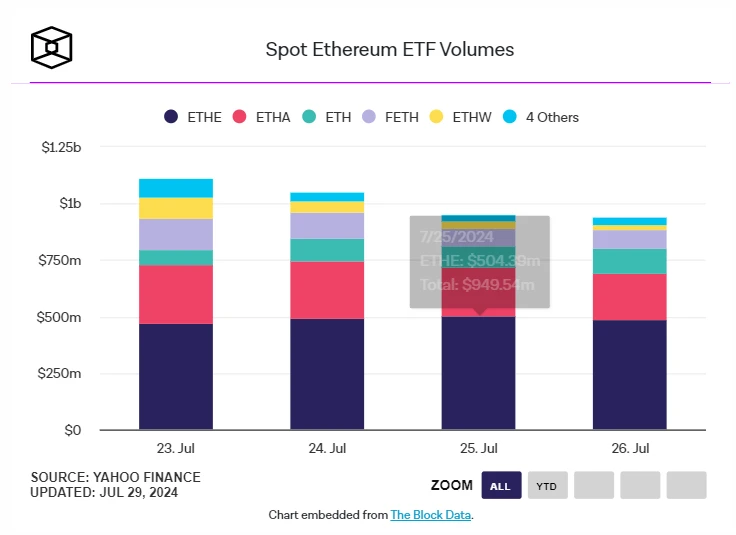
Spot Ethereum ETF trading volume is dominated by Grayscales ETHE, with a market share of approximately 52% on Friday, followed by BlackRocks ETHA, Grayscales ETH and Fidelitys FETH, with trading volume shares of 21.7%, 12% and 8.4%, respectively.

Although Bitcoin ETF trading volume is currently at its lowest level since its launch, Ethereum ETFs accounted for 55% of Bitcoin ETF trading volume ($7.35 billion) in the same period last week.
Again, it’s early days and an Ethereum ETF could also experience a slowdown after its initial launch. However, inflows and volumes excluding ETHE and GBTC make up a higher percentage of the Bitcoin ETF data than most analysts expect, at 15-25%.
According to The Block’s data dashboard, spot Ethereum ETF trading volume has also quickly surpassed that of existing Ethereum futures ETF products, accounting for 99.3% of the market share as of Friday.
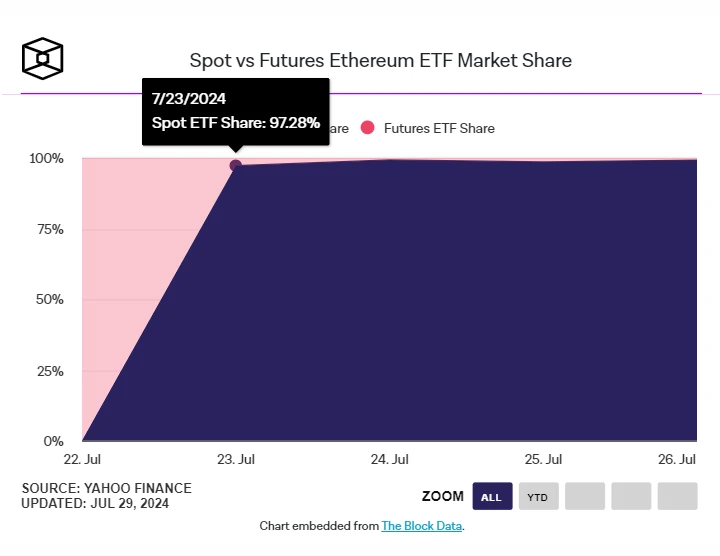
In comparison, spot Bitcoin ETFs account for approximately 92.75% of the trading volume market share compared to Bitcoin futures ETFs.
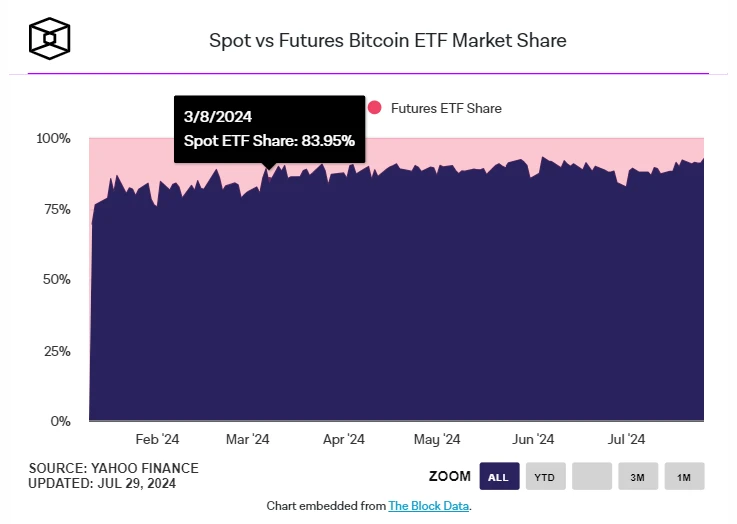
Global downturn
The launch of the US spot Ethereum ETF comes amid a more gloomy global situation, with global net inflows into digital asset investment products at just $245 million, according to the latest report from asset management firm CoinShares.
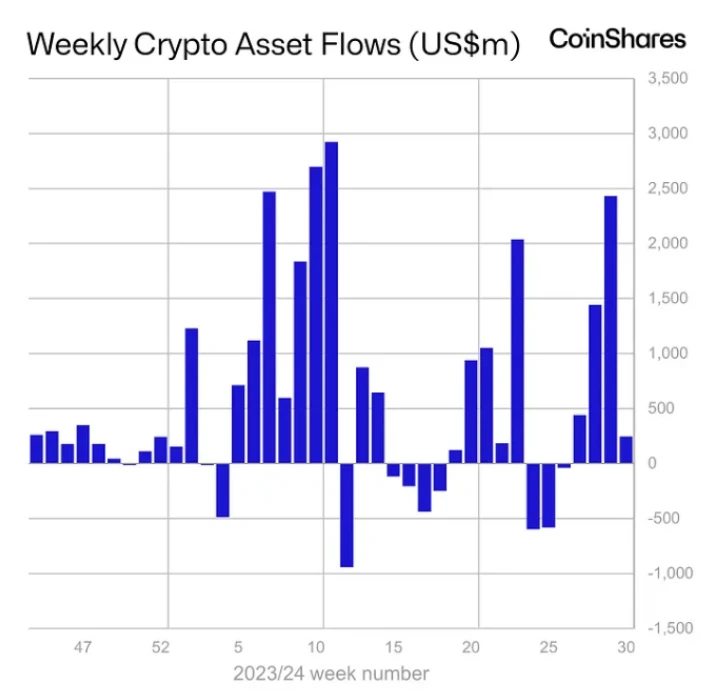
Last week, global Bitcoin investment products saw a net inflow of $519 million, bringing inflows to $3.9 billion in July. “We believe that U.S. campaign rhetoric about Bitcoin as a potential strategic reserve asset and the increased likelihood of a September 2024 rate cut by the Federal Reserve may be responsible for the renewed investor confidence,” wrote James Butterfill, head of research at CoinShares.
Butterfill added that trading volumes also rose to their highest level since May last week, reaching $14.8 billion, driven by the launch of a new Ethereum spot ETF in the United States.
Butterfill said: The launch of the U.S. spot Ethereum ETF brought the largest inflows since December 2020, with newly issued ETFs seeing inflows of $2.2 billion, while ETH ETP volume increased 542%. However, this figure includes approximately $1 billion in seed funding for the Grayscale Mini Trust ETF (ETH), plus $1.5 billion in net outflows from Grayscales converted ETHE products, for a total net outflow of $285 million from global Ethereum investment products last week.
Butterfield noted that crypto investment products now have total assets under management of $99.1 billion globally, with net inflows hitting a record $20.5 billion so far this year.
According to The Blocks Ethereum price page, Ether is currently trading at $3,389, up 4.3% in the past 24 hours but down 3% in the past week.
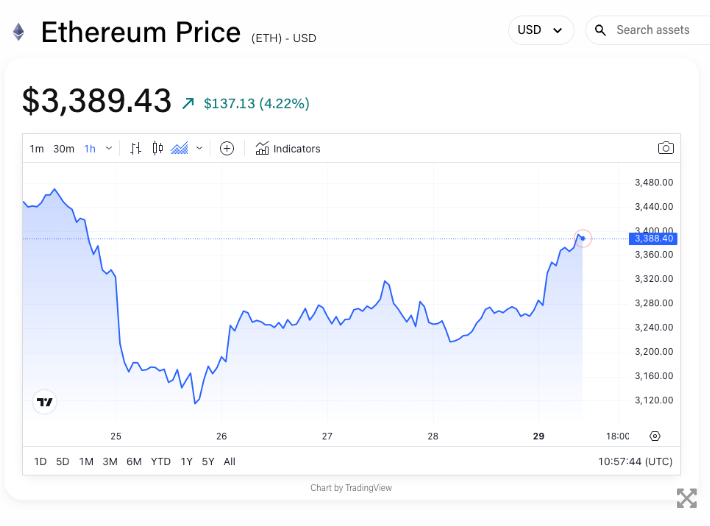
ETH/USD price chart. Image source: The Block/TradingView.
This article is sourced from the internet: Ethereum spot ETF first week data: Grayscale ETHE net outflow of funds reached $1.5 billion
Auteur original : Pzai, Foresight News Préface Avec la chute du nombre d'utilisateurs actifs quotidiens de Friend.techs à moins de 100, le réseau social cryptographique semble se retirer de la tendance. D'un côté, les projets sociaux basés sur le modèle économique cryptographique perdent de l'attention ; de l'autre, les applications liées au réseau social cryptographique telles que Farcaster et Solana Blinks utilisent différents points d'entrée pour faire du réseautage social un moyen de divertissement, apportant de nouvelles possibilités de croissance à l'écosystème. Cet article espère explorer comment construire un réseau social cryptographique en fonction des caractéristiques de chaque projet. Qu'est-il arrivé à Friend.tech ? Oui, peu de gens mentionnent aujourd'hui le très populaire Friend.tech. Certaines personnes regrettent peut-être encore l'effervescence de l'entrée précoce, et certaines personnes regrettent la dopamine lors de l'achat et de la vente de clés.







